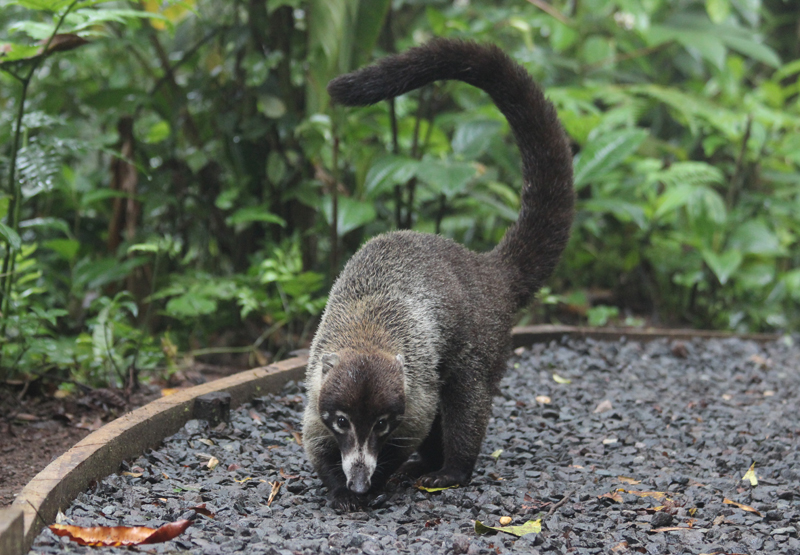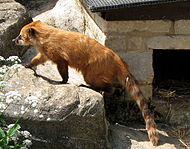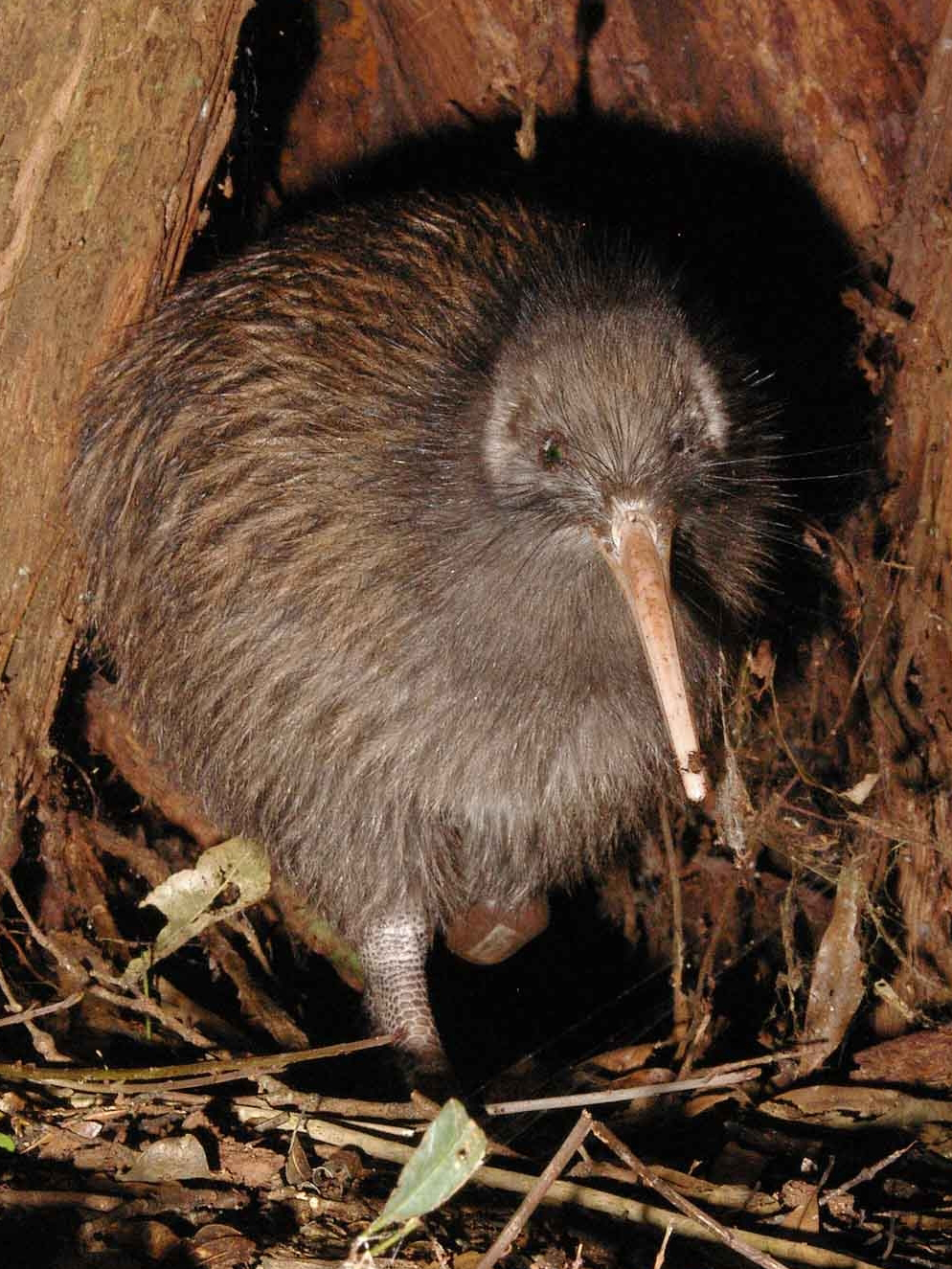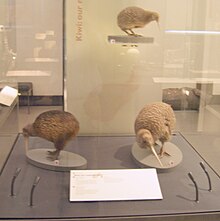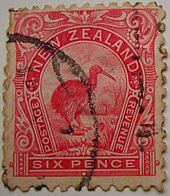Kiwi (pronounced
KEE-wee[4]) or
kiwis are
flightless birds native to
New Zealand, in the
genus Apteryx and family
Apterygidae. Approximately the size of a domestic chicken, kiwi are by far the smallest living
ratites (which also consist of
ostriches,
emus,
rheas, and
cassowaries), and lay the largest
egg in relation to their body size of any species of bird in the world.
[5]
DNA sequence comparisons have yielded the surprising conclusion that kiwi are much more closely related to the extinct Malagasy
elephant birds than to the
moa with which they shared New Zealand.
[6] There are five recognised species, two of which are currently
endangered, another two of which are
vulnerable, and one of which is
near-threatened. All species have been negatively affected by historic
deforestation
but currently the remaining large areas of their forest habitat are
well protected in reserves and national parks. At present, the greatest
threat to their survival is predation by invasive mammalian predators.
The unique
adaptations
of kiwi, such as their large eggs, short and stout legs, or using their
nostrils at the end of their long beak to detect prey before they ever
see it, have helped the bird to become internationally well-known.
The kiwi is an
icon of New Zealand, and the association is so strong that the term
Kiwi is used internationally as the colloquial
demonym for New Zealanders.
[7]
Etymology
The
Māori language word
kiwi is generally accepted to be "of imitative origin" from the call.
[8] However, some linguists derive the word from
Proto-Nuclear Polynesian *kiwi, which refers to
Numenius tahitiensis, the
bristle-thighed curlew, a migratory bird that winters in the tropical Pacific islands.
[9]
With its long decurved bill and brown body, the curlew resembles the
kiwi. So when the first Polynesian settlers arrived, they may have
applied the word kiwi to the new-found bird.
[10] The genus name
Apteryx is derived from
Ancient Greek "without wing":
a-, "without" or "not";
pterux, "wing".
[11]
The name is usually uncapitalised, with the plural either the
anglicised "kiwis"
[12] or, consistent with the Māori language, appearing as "kiwi" without an "-s".
[13]
Taxonomy and systematics
Although it was long presumed that the kiwi was closely related to the other New Zealand ratites, the
moa, recent
DNA studies have identified its closest relative as the extinct
elephant bird of
Madagascar,
[6][14] and among extant ratites, the kiwi is more closely related to the
emu and the
cassowaries than to the moa.
[6][15]
Research published in 2013 on an extinct genus,
Proapteryx, known from the
Miocene deposits of the
Saint Bathans Fauna, found that it was smaller and probably capable of flight, supporting the hypothesis that the ancestor of the kiwi reached
New Zealand independently from moas, which were already large and flightless by the time kiwi appeared.
[16]
Species
Clockwise from left: brown kiwi (Apteryx australis), little spotted kiwi (Apteryx owenii) and great spotted kiwi (Apteryx haastii) at Auckland War Memorial Museum
There are five known species of kiwi, as well as a number of subspecies.
Relationships in the genus Apteryx[17]
- The largest species is the great spotted kiwi or Roroa, Apteryx haastii,
which stands about 45 cm (18 in) high and weighs about 3.3 kg (7.3 lb)
(males about 2.4 kg (5.3 lb)). It has grey-brown plumage with lighter
bands. The female lays just one egg, which both parents then incubate.
The population is estimated to be over 20,000, distributed through the
more mountainous parts of northwest Nelson, the northern West Coast, and
the Southern Alps.[18]
- The small little spotted kiwi, Apteryx owenii
is unable to withstand predation by introduced pigs, stoats and cats,
which have led to its extinction on the mainland. About 1350 remain on Kapiti Island.
It has been introduced to other predator-free islands and appears to be
becoming established with about 50 'Little Spots' on each island. A
docile bird the size of a bantam, it stands 25 cm (9.8 in) high and the female weighs 1.3 kg (2.9 lb). She lays one egg, which is incubated by the male.[19]
- The Okarito kiwi, also known as the rowi or Okarito brown kiwi, Apteryx rowi, first identified as a new species in 1994,[20]
is slightly smaller, with a greyish tinge to the plumage and sometimes
white facial feathers. Females lay as many as three eggs in a season,
each one in a different nest. Male and female both incubate. The
distribution of these kiwi is limited to a small area on the west coast
of the South Island
of New Zealand. However, studies of ancient DNA have revealed that, in
prehuman times, it was far more widespread up the west coast of the
South Island and was present in the lower half of the North Island,
where it was the only kiwi species detected.[21]
- The southern brown kiwi, Tokoeka, or Common kiwi, Apteryx australis,
is a relatively common species of kiwi, known from south and west parts
of the South Island, that occurs at most elevations. It is
approximately the size of the great spotted kiwi and is similar in
appearance to the brown kiwi, but its plumage is lighter in colour.
Ancient DNA studies have shown that, in prehuman times, the distribution
of this species included the east coast of South Island.[21] There are several subspecies of the Tokoeka recognised:
- The Stewart Island southern brown kiwi, Apteryx australis lawryi, is a subspecies of Tokoeka from Stewart Island/Rakiura.[22]
- The Northern Fiordland southern brown kiwi (Apteryx australis ?) and Southern Fiordland tokoeka (Apteryx australis ?) live in the remote southwest part of the South Island known as Fiordland. These sub-species of tokoeka are relatively common and are nearly 40 cm (16 in) tall.[citation needed]
- The Haast southern brown kiwi, Haast tokoeka, Apteryx australis ‘Haast’,
is the rarest subspecies of kiwi with only about 300 individuals. It
was identified as a distinct form in 1993. It occurs only in a
restricted area in the South Island's Haast Range
of the Southern Alps at an altitude of 1,500 m (4,900 ft). This form is
distinguished by a more strongly downcurved bill and more rufous
plumage.[22]
- The North Island brown kiwi, Apteryx mantelli or Apteryx australis
before 2000 (and still in some sources), is widespread in the northern
two-thirds of the North Island and, with about 35,000 remaining,[23]
is the most common kiwi. Females stand about 40 cm (16 in) high and
weigh about 2.8 kg (6.2 lb), the males about 2.2 kg (4.9 lb). The North
Island brown has demonstrated a remarkable resilience: it adapts to a
wide range of habitats, even non-native forests and some farmland. The
plumage is streaky red-brown and spiky. The female usually lays two
eggs, which are incubated by the male.[24]
Description
1860s drawing of Apteryx, illustrating its distinctive features, including long beak, short legs and claws, and dark hair-like feathers.
Their adaptation to a terrestrial life is extensive: like all the other
ratites (
ostrich,
emu,
rhea and
cassowary), they have no
keel on the
sternum to anchor wing muscles. The
vestigial
wings are so small that they are invisible under the bristly,
hair-like, two-branched feathers. While most adult birds have bones with
hollow insides to minimise weight and make flight practicable, kiwi
have marrow, like mammals and the young of other birds. With no
constraints on weight due to flight requirements, brown kiwi females
carry and lay a single egg that may weigh as much as 450 g (16 oz). Like
most other ratites, they have no
uropygial gland (preen gland). Their bill is long, pliable and sensitive to touch, and their eyes have a reduced
pecten. Their feathers lack
barbules and
aftershafts, and they have large
vibrissae around the
gape. They have 13 flight feathers, no tail and a small
pygostyle. Their
gizzard is weak and their
caecum is long and narrow.
[25]
The eye of the kiwi is the smallest relative to body mass in all
avian species resulting in the smallest visual field as well. The eye
has small specialisations for its
nocturnal lifestyle but relies on its other senses more heavily (auditory, olfactory, and
somatosensory
system). The sight of the kiwi is so underdeveloped that blind
specimens have been observed in nature showing how little they rely on
sight for survival and foraging. In an experiment, it was observed that
one-third of a population of
A. rowi in New Zealand under no
environmental stress had ocular lesions in one or both eyes. The same
experiment examined three specific specimens that showed complete
blindness and found them to be in good physical standing outside of
ocular abnormalities.
[26]
Unlike virtually every other
palaeognath,
which are generally small-brained by bird standards, kiwi have
proportionally large encephalisation quotients. Hemisphere proportions
are even similar to those of
parrots and
songbirds, though there is no evidence of similarly complex behaviour.
[27]
Behaviour and ecology
Before the arrival of humans in the 13th century or earlier, New Zealand's only endemic mammals were
three species of bat, and the
ecological niches
that in other parts of the world were filled by creatures as diverse as
horses, wolves and mice were taken up by birds (and, to a lesser
extent, reptiles, insects and gastropods).
[28]
The kiwi's mostly nocturnal habits may be a result of habitat
intrusion by predators, including humans. In areas of New Zealand where
introduced predators have been removed, such as sanctuaries, kiwi are
often seen in daylight. They prefer subtropical and temperate
podocarp
and beech forests, but they are being forced to adapt to different
habitat, such as sub-alpine scrub, tussock grassland, and the mountains.
[25]
Kiwi have a highly developed sense of smell, unusual in a bird, and are
the only birds with nostrils at the end of their long beaks. Kiwi eat
small invertebrates, seeds, grubs, and many varieties of worms. They
also may eat fruit, small crayfish, eels and amphibians. Because their
nostrils are located at the end of their long beaks, kiwi can locate
insects and worms underground using their keen sense of smell, without
actually seeing or feeling them.
[25]
This sense of smell is due to a highly developed olfactory chamber and
surrounding regions. It is a common belief that the kiwi relies solely
on its sense of smell to catch prey but this has not been scientifically
observed. Lab experiments have suggested that
A. australis can
rely on olfaction alone but is not consistent under natural conditions.
Instead, the kiwi may rely on auditory and/or vibrotactile cues.
[29]
Once bonded, a male and female kiwi tend to live their entire lives
as a monogamous couple. During the mating season, June to March, the
pair call to each other at night, and meet in the nesting burrow every
three days. These relationships may last for up to 20 years.
[30] They are unusual among other birds in that, along with some raptors, they have a functioning pair of
ovaries. (In most birds and in
platypuses, the right ovary never matures, so that only the left is functional.
[25][31][32])
Kiwi eggs can weigh up to one-quarter the weight of the female.
Usually, only one egg is laid per season. The kiwi lays the biggest egg
in proportion to its size of any bird in the world,
[33]
so even though the kiwi is about the size of a domestic chicken, it is
able to lay eggs that are about six times the size of a chicken's egg.
[34] The eggs are smooth in texture, and are ivory or greenish white.
[35] The male incubates the egg, except for the great spotted kiwi,
A. haastii, in which both parents are involved. The incubation period is 63–92 days.
[25]
Producing the huge egg places significant physiological stress on the
female; for the thirty days it takes to grow the fully developed egg,
the female must eat three times her normal amount of food. Two to three
days before the egg is laid there is little space left inside the female
for her stomach and she is forced to fast.
[36]
Lice in the genus
Apterygon[37][38][39] and in the subgenus
Rallicola (
Aptericola)
[40][41] are exclusively
ectoparasites of kiwi species.
[42]
Status and conservation
Nationwide studies show that only around 5–10% of kiwi chicks survive to adulthood without management.
[43][44]
However, in areas under active pest management, survival rates for
North Island brown kiwi can be far higher. For example, prior to a joint
1080 poison operation undertaken by DOC and the
Animal Health Board in
Tongariro Forest in 2006, 32 kiwi chicks were radio-tagged. 57% of the radio-tagged chicks survived to adulthood.
Sanctuaries
In 2000, the
Department of Conservation set up five kiwi sanctuaries focused on developing methods to protect kiwi and to increase their numbers.
- There are three kiwi sanctuaries in the North Island:
- Whangarei Kiwi Sanctuary (for Northland brown kiwi)
- Moehau Kiwi Sanctuary on the Coromandel Peninsula (Coromandel brown kiwi)
- Tongariro Kiwi Sanctuary near Taupo (western brown kiwi)
- and two in the South Island:
A number of other
mainland conservation islands and fenced sanctuaries have significant populations of kiwi, including:
North island brown kiwi were introduced to the
Cape Sanctuary in
Hawke's Bay between 2008 and 2011, which in turn provided captive-raised chicks that were released back into Maungataniwha Native Forest.
[45]
Operation "Nest Egg"
Operation Nest Egg is a programme run by the BNZ Save the Kiwi Trust—a partnership between the
Bank of New Zealand, the Department of Conservation and the
Royal Forest and Bird Protection Society.
Kiwi eggs and chicks are removed from the wild and hatched and/or
raised in captivity until big enough to fend for themselves—usually when
they weigh around 1200 grams (42 ounces). They are then returned to the
wild. An Operation Nest Egg bird has a 65% chance of surviving to
adulthood—compared to just 5% for wild-hatched and raised chicks.
[46] The tool is used on all kiwi species except
little spotted kiwi.
1080 poison
In 2004, anti-1080 activist Phillip Anderton posed for the New
Zealand media with a kiwi he claimed had been poisoned. An investigation
revealed that Anderton lied to journalists and the public.
[47]
He had used a kiwi that had been caught in a possum trap. Extensive
monitoring shows that kiwi are not at risk from the use of biodegradable
1080 poison.
[48]
Threats
Introduced mammalian predators,
namely stoats, dogs, ferrets, and cats, are the number one threat to
kiwi. The biggest threat to kiwi chicks is stoats, while dogs are the
biggest threat to adult kiwi.
[44] Stoats
are responsible for approximately half of kiwi chick deaths in many
areas through New Zealand. Young kiwi chicks are vulnerable to stoat
predation until they reach about 1–1.2 kg in weight, at which time they
can usually defend themselves. Cats also to a lesser extent prey on kiwi
chicks.
[44]
These predators can cause large and abrupt declines in populations. In
particular, dogs find the distinctive strong scent of kiwi irresistible
and easy to track, such that they can catch and kill kiwi in seconds.
Motor vehicle strike is a threat to all kiwi where roads cross through
their habitat. Badly set
possum traps often kill or maim kiwi.
[49]
Habitat destruction is another major threat to kiwi; restricted
distribution and small size of some kiwi populations increases their
vulnerability to inbreeding.
[44]
Research has shown that the combined effect of predators and other
mortality (accidents etc.) results in less than 5% of kiwi chicks
surviving to adulthood.
[43]
Relationship to humans
Detail of the bottom edge of a
kahu kiwi, showing the distinctive hair-like nature of the kiwi feathers.
The
Māori traditionally believed that kiwi were under the protection of
Tane Mahuta, god of the forest. They were used as food and their feathers were used for
kahu kiwi—ceremonial cloaks.
[50]
Today, while kiwi feathers are still used, they are gathered from birds
that die naturally or through road accidents or predation, or from
captive birds.
[51] Kiwi are no longer hunted and some Maori consider themselves the birds' guardians.
[10]
Scientific documentation
In 1813,
George Shaw named the genus
Apteryx in his
species description of the southern brown kiwi, which he called "the southern apteryx". Captain Andrew Barclay of the ship
Providence provided Shaw with the specimen. Shaw's description was accompanied by two plates, engraved by
Frederick Polydore Nodder; they were published in volume 24 of
The Naturalist's Miscellany.
[52]
Zoos
In 1851,
London Zoo became the first zoo to keep kiwi. The first captive breeding took place in 1945.
[53] As of 2007 only 13 zoos outside New Zealand hold kiwi.
[54] The
Frankfurt Zoo has 12, the
Berlin Zoo has seven,
Walsrode Bird Park has one, the
Avifauna Bird Park in the Netherlands has three, the
San Diego Zoo has five, the
San Diego Zoo Safari Park has one, the
National Zoo in Washington, DC has eleven, the
Smithsonian Conservation Biology Institute has one, and the
Columbus Zoo and Aquarium has three.
[55][56]
As a national symbol
The kiwi on an 1898 New Zealand stamp
The kiwi as a symbol first appeared in the late 19th century in New
Zealand regimental badges. It was later featured in the badges of the
South Canterbury Battalion in 1886 and the Hastings Rifle Volunteers in
1887. Soon after, the kiwi appeared in many military badges; and in
1906, when
Kiwi Shoe Polish was widely sold in the UK and the US, the symbol became more widely known.
[57]
During the First World War, the name
"kiwi" for New Zealand soldiers came into general use, and a giant kiwi (now known as the
Bulford kiwi), was carved on the chalk hill above
Sling Camp in England. Usage has become so widespread that all New Zealanders overseas and at home are now commonly referred to as "
Kiwis".
[58]
The kiwi has since become the most well-known national symbol for New
Zealand, and the bird is prominent in the coat of arms, crests and
badges of many New Zealand cities, clubs and organisations; at the
national level, the red silhouette of a kiwi is in the centre of the
roundel of the
Royal New Zealand Air Force.
[35][59] The kiwi is featured in the logo of the
New Zealand Rugby League, and the
New Zealand national rugby league team are nicknamed the Kiwis.
The reverse of a New Zealand dollar coin contains an image of a kiwi, and in
currency trading the
New Zealand dollar is often referred to as "the kiwi".
[60]
See also

